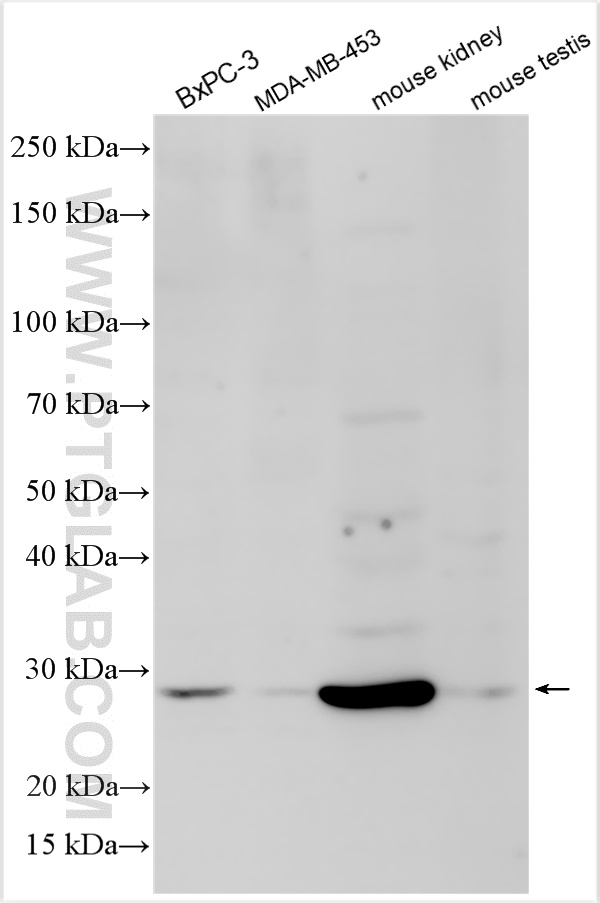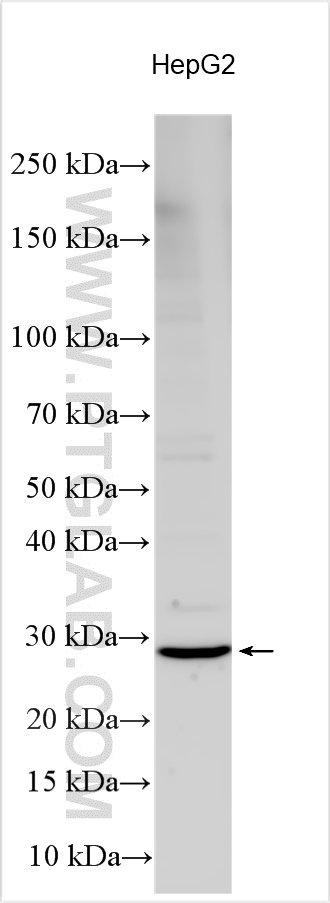验证数据展示
经过测试的应用
| Positive WB detected in | BxPC-3 cells, HepG2 cells, MDA-MB-453 cells, mouse kidney tissue, mouse testis tissue |
推荐稀释比
| 应用 | 推荐稀释比 |
|---|---|
| Western Blot (WB) | WB : 1:500-1:3000 |
| It is recommended that this reagent should be titrated in each testing system to obtain optimal results. | |
| Sample-dependent, Check data in validation data gallery. | |
产品信息
32165-1-AP targets TNRC18 in WB, ELISA applications and shows reactivity with human, mouse samples.
| 经测试应用 | WB, ELISA Application Description |
| 经测试反应性 | human, mouse |
| 免疫原 | TNRC18 fusion protein Ag37483 种属同源性预测 |
| 宿主/亚型 | Rabbit / IgG |
| 抗体类别 | Polyclonal |
| 产品类型 | Antibody |
| 全称 | trinucleotide repeat containing 18 |
| 别名 | Trinucleotide repeat-containing gene 18 protein, Trinucleotide Repeat Containing 18, Long CAG trinucleotide repeat-containing gene 79 protein, KIAA1856, CAGL79 |
| 计算分子量 | 31 kDa |
| 观测分子量 | 29 kDa |
| GenBank蛋白编号 | BC131808 |
| 基因名称 | TNRC18 |
| Gene ID (NCBI) | 84629 |
| RRID | AB_3670212 |
| 偶联类型 | Unconjugated |
| 形式 | Liquid |
| 纯化方式 | Antigen affinity Purification |
| UNIPROT ID | O15417 |
| 储存缓冲液 | PBS with 0.02% sodium azide and 50% glycerol , pH 7.3 |
| 储存条件 | Store at -20°C. Stable for one year after shipment. Aliquoting is unnecessary for -20oC storage. |
背景介绍
Trinucleotide repeat containing 18 (TNRC18, also known as CAGL79 and KIAA1856) is a nucleic-acid-binding protein, which recognizes H3K9me3 to mediate the silencing of ERV class I (ERV1) elements and acts as a chromatin-associated regulator of ERVs (PMID: 27980689; 37938770). It is located in the cytosol, mitochondrion, and nucleus (PMID: 19262598). The mutation in TNRC18 may cause Fazio-Londe disease (PMID: 38188848).
实验方案
| Product Specific Protocols | |
|---|---|
| WB protocol for TNRC18 antibody 32165-1-AP | Download protocol |
| Standard Protocols | |
|---|---|
| Click here to view our Standard Protocols |

